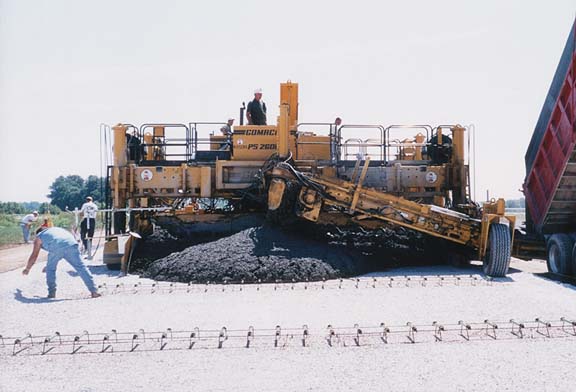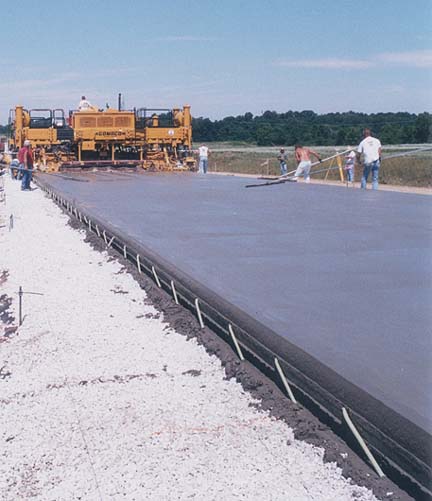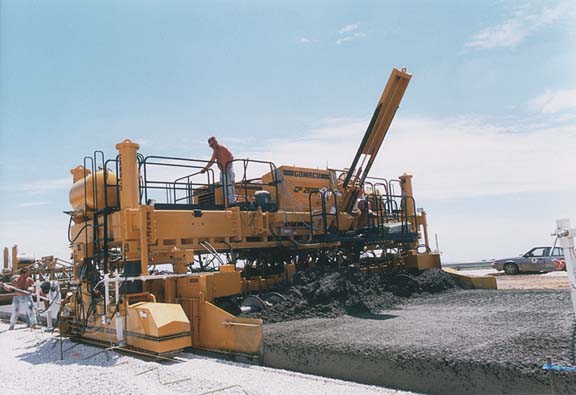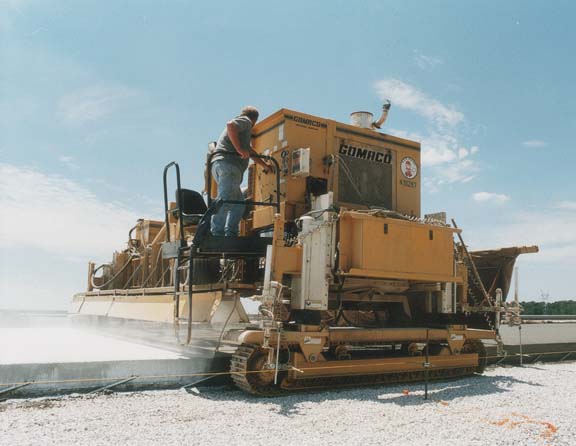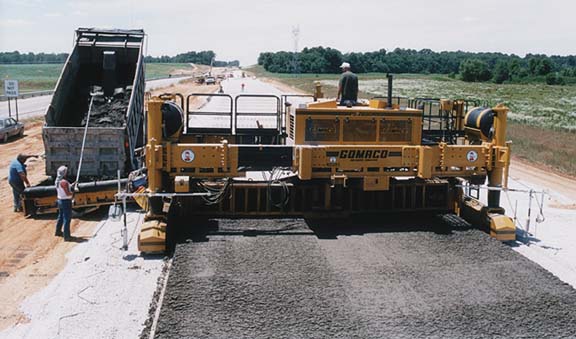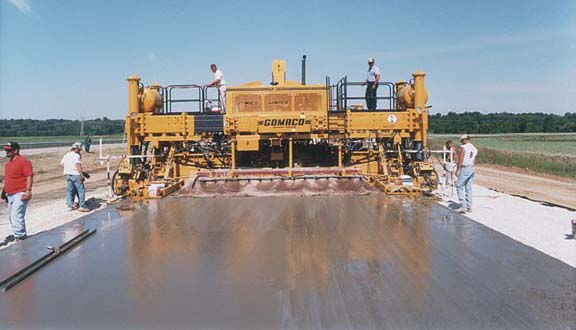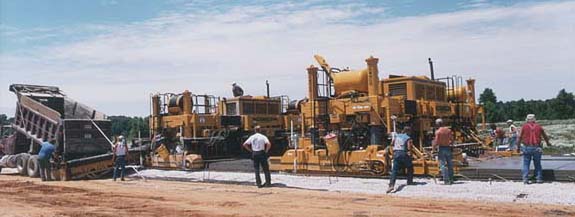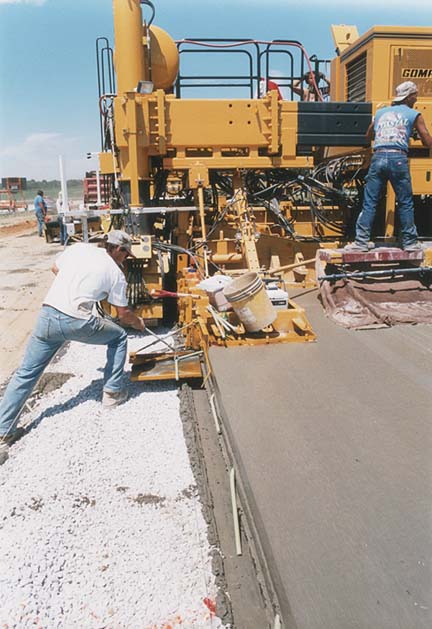GOMACO World Index --- GOMACO World 27.4 - January 2000
Exceeded Expectations
E & B Paving, Inc., based out of Anderson, Indiana, purchased a GP-2600 paver earlier this year to add to their PS-2600 placer/spreader and T/C-600 texture/cure and complete their GOMACO paving train. Since delivery, it has been paving almost non-stop on multi-million dollar projects across the state of Indiana.
One of the projects they paved was 4.83km (three miles) of U.S. 50, 16.1km (10 mi) east of Vincennes. Heavy traffic from coal trucks and other vehicles had taken their toll on the roadway.
The Indiana Department of Transport (INDOT) decided to rebuild and relocate U.S. 50 to a four lane, 7.32m (24 ft) wide road with concrete shoulders.
E & B Paving, subcontractor to Crider & Crider Construction Company, began work on the project on October 1, 1998.
"The project involved heavy grading, drainage, cross structures, clearing and paving," Ronald Zink, one of the Vice Presidents at E & B Paving, said. "The actual pavement section was 275mm (11 in) of plain concrete on an open-graded subbase on top of the subgrade."
The subbase was built 175mm (seven inches) thick according to specs from INDOT. "The subbase is designed to take water away from underneath of the pavement to the underdrain system," Zink said. "It makes the pavement last longer because you don't get the pumping action of water up through the concrete pavement joints."
A PS-2600 led the paving train. "We felt, to get the kind of rides we wanted, a placer/spreader was the only way to accomplish that," Zink said.
The belt on the PS-2600 can be attached to either side of the machine, which comes in handy in tight situations. "Normally we like to have the belt on the left side and our batch trucks all in the median," Zink said. "In some cases, like a project we're currently on in LaFayette, Indiana, it's in an urban area and the median is very tight and narrow. We just put our belt on the right side and wet batch from the outside shoulder."
The GP-2600 slipformed a concrete slab 275mm (11 in) thick and 7.32m (24 ft) wide. Doweled baskets were placed on the grade approximately 5.5m (18 ft) center-to-center. The joints were transverse, contraction joints with 32mm (1.25 in) epoxy-coated dowels spaced 305mm (12 in) center-to-center.
A front-mounted bar inserter on the GP-2600 placed 914mm (36 in) long #6 epoxy-coated bars every 914mm (36 in) to form a longitudinal joint in the pavement. The center-line joint was required by INDOT.
"There were various places on the paving train where we could have placed the bar," Zink said. "We felt we wanted to put it ahead of the paver so we would get uniformity in the depth of that bar, which is supposed to be placed midway between the top to the bottom of the pavement. It worked very well."
Side-mounted bar inserters on both sides of the paver were also an added feature on the GP-2600. "We placed #6 epoxy-coated bent bars every 914mm (36 in), on each side of the mainline," Zink said. "The primary purpose was, after the mainline was paved, those bars were bent out straight in order to tie the concrete shoulders to the mainline pavement."
Design specs from INDOT called for a 3.05m (10 ft) outside shoulder and a 1.22m (four foot) inside shoulder. Rumble strips were every 18.29m (60 ft). All of the inside shoulder was paved with a Commander III.
Approximately 158,859m2 (190,000 yd2) of concrete pavement was placed on the project. "Primarily everything on the project was concrete including the crossovers, turn lanes and approaches," Zink said. "There was a small amount of blacktop for S-lines or country roads, just to take the traffic from the concrete approaches back to the existing county roads."
Concrete was mixed on-site with E & B Paving's Rex Model S concrete plant. The concrete was a fly-ash mix containing limestone, sand, cement, and admixtures for water reducer and air entrainment. Slump was 38mm (1.5 in). Average production was around 237m3 (310 yd3) per hour during the paving process.
INDOT requirements for rideability allowed 25mm (one inch) for every 0.16km (0.1 mi). "On a lot of the INDOT projects there is a three percent incentive," Zink said. "We were able to attain a majority of the incentive."
Good rideability doesn't just happen. "To get a good ride, it takes a team effort as far as the quality of the mix being produced, the equipment that you are using, the subbase, the people running the equipment and the supervision," Zink said. "It's not just one thing, it's several things."
Better rideability is only one of the advantages of the GP-2600. "We like the two-speed motors, the high-speed for mobility and the low-speed for paving. The front-bar and side-bar inserters work well. We have the paving kit with the additional auger in the grout box. We feel this helps us as we go through steep curves. We also like the profile pan, the sensors and the versatility of making changes in widths and depths," Zink said.
The final machine in the paving train is the T/C-600. INDOT requires tining on their pavements to prevent hydroplaning. "The T/C-600 is set up very well. It has sensors for elevation on both sides of the machine to get an exact tining action every time," Zink said. "That's very important as far as uniformity and meeting the specifications for tining required on the pavement. It also crowns in the middle to allow crown changes to be made when going through superelevated curves, which is outstanding."
E & B Paving finished the US 50 project in September of this year. They have several projects already lined up for their paving train.
"The other thing I like about GOMACO is their school system and their services," Zink said. "Last spring we sent eight of our employees to GOMACO University and there was a lot of good rapport and good information. We've had several GOMACO servicemen out to help set up new equipment. Our guys know each other and it's a real joy to see those servicemen.
"GOMACO's a very good organization as far as we're concerned, from the service, University, product, PR, to just about everything."
Subscribe to Receive GOMACO World Magazine
